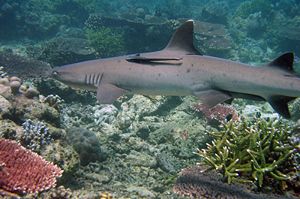Seven intrepid men sail the waters off Tubbataha Reef aboard a striking black-and-white “panda” yacht called MY Navorca. They navigate the rough currents of the Sulu Sea and skim across waves as tall as houses to stand guard over the marine sanctuary.
Meet “Ocean’s Seven,” a team of conservation sailors at the helm of World Widelife Fund for Nature (WWF)-Philippines’ only “floating office” in the country.
Every day, the team—composed of Capt. Ronald de Roa, Dondon Cayanan, Herlito Dagaraga, Arnel Escobin, Jun Gayoma, Jun Magbanua and Jeruel Magalona—guides WWF’s research and safeguards work at Tubbataha Reefs Natural Park and the nearby island-town of Cagayancillo in Palawan province.
“They are truly our behind-the-scenes heroes,” Marivel Dygico, WWF Tubbataha Reef project manager, said of the team whose moniker was a play on the title of the Hollywood crime caper “Ocean’s Eleven.”
“Without the efforts of our crewmen, WWF wouldn’t be able to help conserve Tubbataha,” Dygico said in a special profile of the group prepared for the Inquirer.
The WWF is one of the partners of the Tubbataha Management Office, the implementing arm of the Tubbataha Protected Area Management Board (TPAMB) that carries out day-to-day operations in the protection and conservation effort.
Tubbataha Reefs Natural Park lies at the center of the Sulu Sea. It protects almost 100,000 hectares of high-quality marine habitats containing three atolls and a large area of deep sea.
World heritage site
Home to whales, dolphins, sharks, turtles and Napoleon wrasse, the park supports more than 350 species of coral and almost 500 species of fish. For this, it has been declared a World Heritage Site by the United Nations Educational, Scientific and Cultural Organization (Unesco).
The reserve also protects one of the few remaining colonies of breeding seabirds in the region, according to Unesco.
In 1999, in response to overfishing, poaching and exploitation of the reef, the TPAMB, a policy-making body, was established to conserve, protect and manage the resources of Tubbataha. It is made up of 19 members from the national and local governments, and the private sector.
Research office in ship
Ocean’s Seven uses the Navorca, a vessel acquired in 2008 through a partnership with Grieg Shipping Group, Grieg Foundation and WWF-Norway. The vessel was recently refitted with state-of-the-art navigation and communications equipment.
The Navorca serves as WWF-Philippines’ research office for Tubbataha in open water.
Its sturdy wood-and-fiber-glass hull spans 80 feet and displaces 70 gross tons. It can accommodate a dozen passengers in bunk beds, and has two weeks’ worth of fuel, water and food on board, according to the nongovernmental organization.
The captain of the ship is De Roa, “a slight man with a quiet demeanor and alert eyes that constantly scan the horizon,” Dygico said.
Waves as large as houses
“Ever seen waves as large as houses?” De Roa said when asked about Ocean’s Seven’s struggles at sea. “Sailors call the giant waves ‘gulong’ (wheel) because ships have to roll with them just to stay afloat,” he said.
He recalled an incident off Antique’s coast in 2008 when the sailors had to navigate through “gulong” waves for days. “[This job is] definitely not for the faint-hearted!” De Roa said.
The 38-year-old seaman started his WWF career in 1999 as a crewman of the organization’s first research vessel, the M/Bca Minerva. He was promoted to captain in 2003 and began piloting the Navorca in 2010.
A father of three, De Roa holds a major patron license, “meaning he can captain any ship up to 500 gross tons,” WWF said.
“A captain has to constantly monitor everything—from the position of the ship to the direction of the current. When bad weather hits—and it always does in the Sulu Sea—you have to work doubly hard to ensure the safety of everyone on board,” he said.
GPS, radar screen
The Navorca comes complete with navigational aids. The ship has a GPS (Global Positioning System) unit, depth sounder, long-distance single-side-band radio, short-distance very-high-frequency radio, radar screen, nautical compass, among other tools.
Magbanua said the ship was also equipped with save-our-lives-at-sea gear. “We have an inflatable raft for 20 people, smoke signal flares, first aid kits, axes, fire extinguishers, etc.” he said.
“A ship at sea must be self-sufficient—so everyone should learn and offer varied skills. Today, you’re a painter, tomorrow a dive master,” said Escobin, another veteran hand.
Dygico said Ocean’s Seven was instrumental in promoting WWF’s research and conservation projects for Tubbataha, where “fish biomass breaches 200 tons per square kilometer.”
“This is five times greater than the productivity of a typical healthy reef, enough to seed eastern Palawan and the adjoining Visayan Sea with fish and invertebrate spawn,” she said.
But Dygico said that while the Tubbataha park was a shining example among other marine protected areas, there was still much to be done to save the rest of the vulnerable Philippine reefs.
40% of reefs damaged
“Consider that less than 5 percent of Philippine coral reefs are in excellent condition and that 40 million Filipinos rely on the sea for food or livelihood,” Dygico said. “Can we really afford to lose what remains to poachers? Not on our watch.”
In a recent report on Philippine coral reef conditions presented in an international forum in Australia, the Protected Areas and Wildlife Bureau of the Department of Environment and Natural Resources said only 1 percent of reefs in the country were in excellent condition as of 2010.
About 40 percent were in poor condition, the report said. DJ Yap
